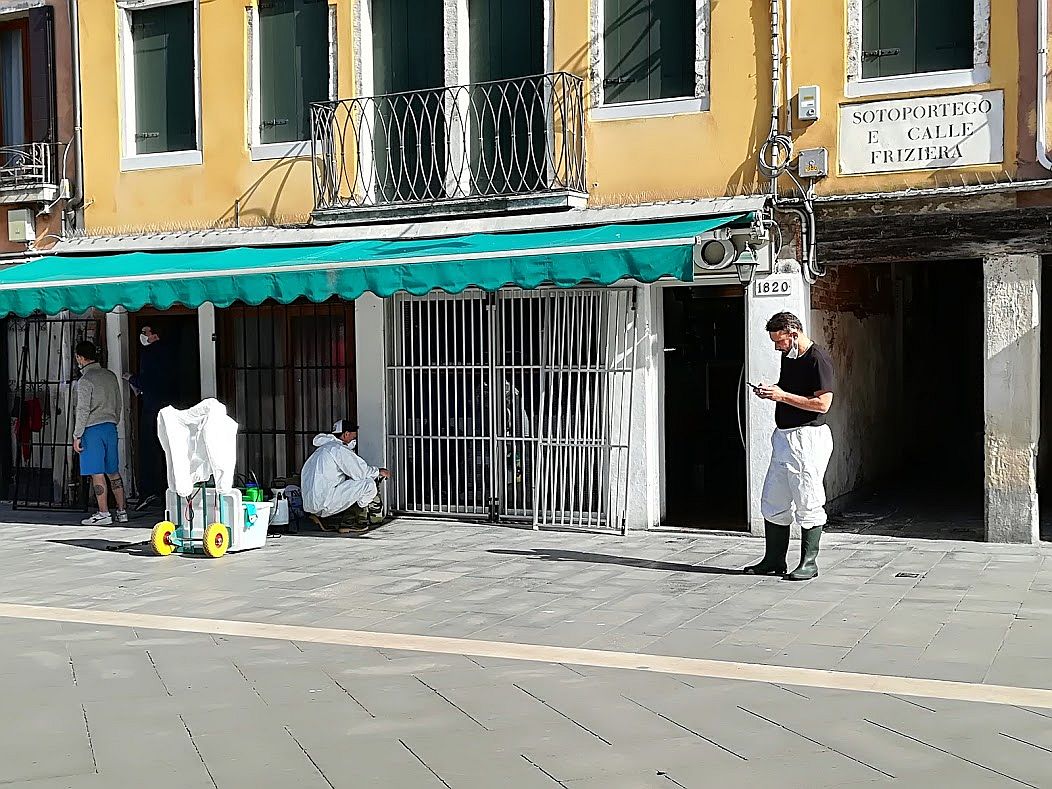
The big day is at hand: Monday, May 18, a whole slew of heretofore closed, locked, stashed-in-a-trunk-in-the-attic businesses will finally be allowed to reopen.
Reading the not-so-fine print on the terms and conditions, though, reveals a huge number of rules that most businesses are racing to accommodate. Even so, it’s going to be extremely hard for them to make up for the lost two and a half months, not to mention begin making something like a profit; lack of tourists is going to be a challenge to overcome, fiscally speaking. I say this in the sense of Mount Everest being a challenge to overcome, physically speaking.
Let’s take these in no order whatsoever. No, let’s take them in the order that affects or interests me. I’m leaving out all sorts of details bearing on gyms, second homes, beaches, and more, each of which carries its own payload of regulations. And bear in mind that these rules may change between towns and regions — national regulation-making seems to have broken down.
General joy breaks forth because now you are allowed to see your friends, but only in the open air, NOT at anybody’s house, and NO PARTIES. You still have to maintain distancing and avoid clumping together in groups. From what I’ve seen in the past few days in the neighborhood, those rules might as well have been promulgated in some Manchu-Tungusic dialect.
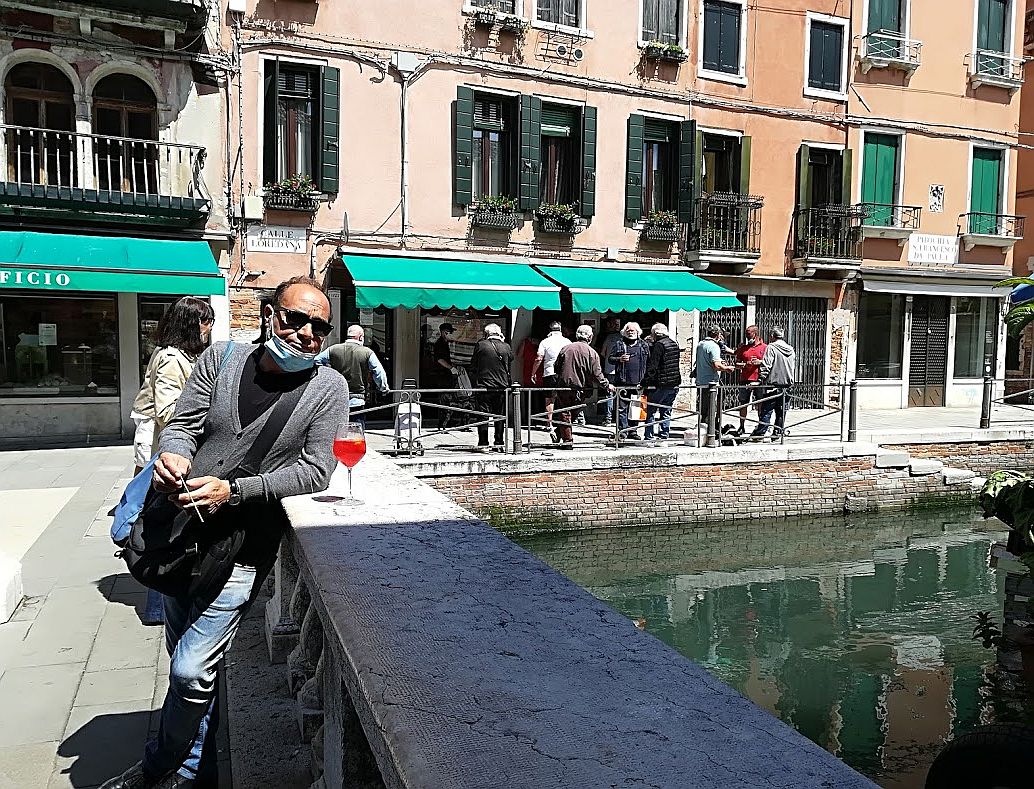
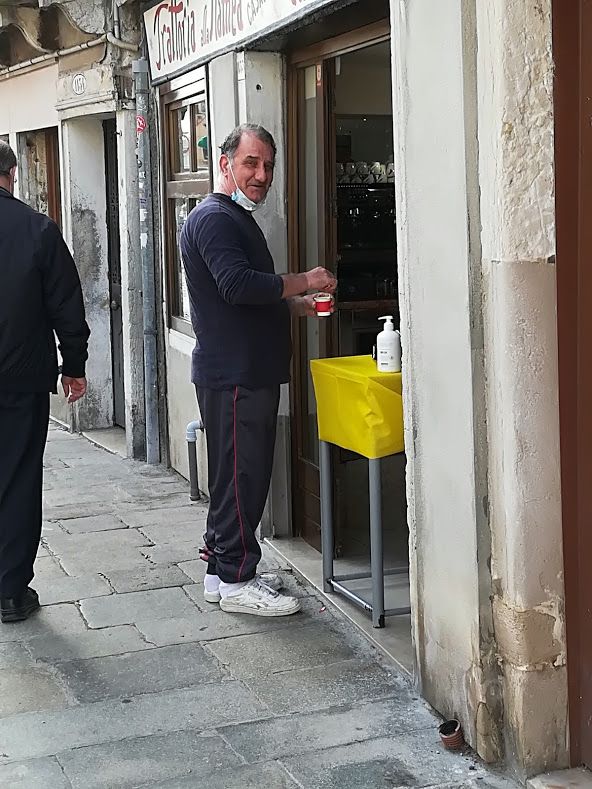
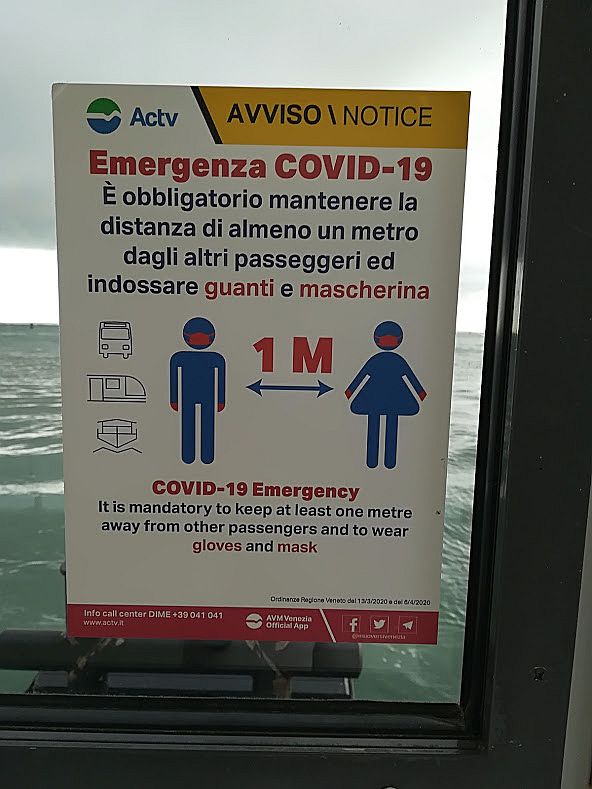
Public transport. You must wear a mask and gloves, and maintain one-meter distancing. That’s pretty simple.
Where it has already started to become complicated is the fact that the passenger limit on the vaporettos is now 55, as opposed to the astronomical number of people — I read “400” somewhere, but maybe that’s an exaggeration? — that used to cram themselves aboard during high season.
So seats have been taken out of service, so to speak. You have to manage your own distancing if you’re standing in the aisle, but the seats leave no room for debate.
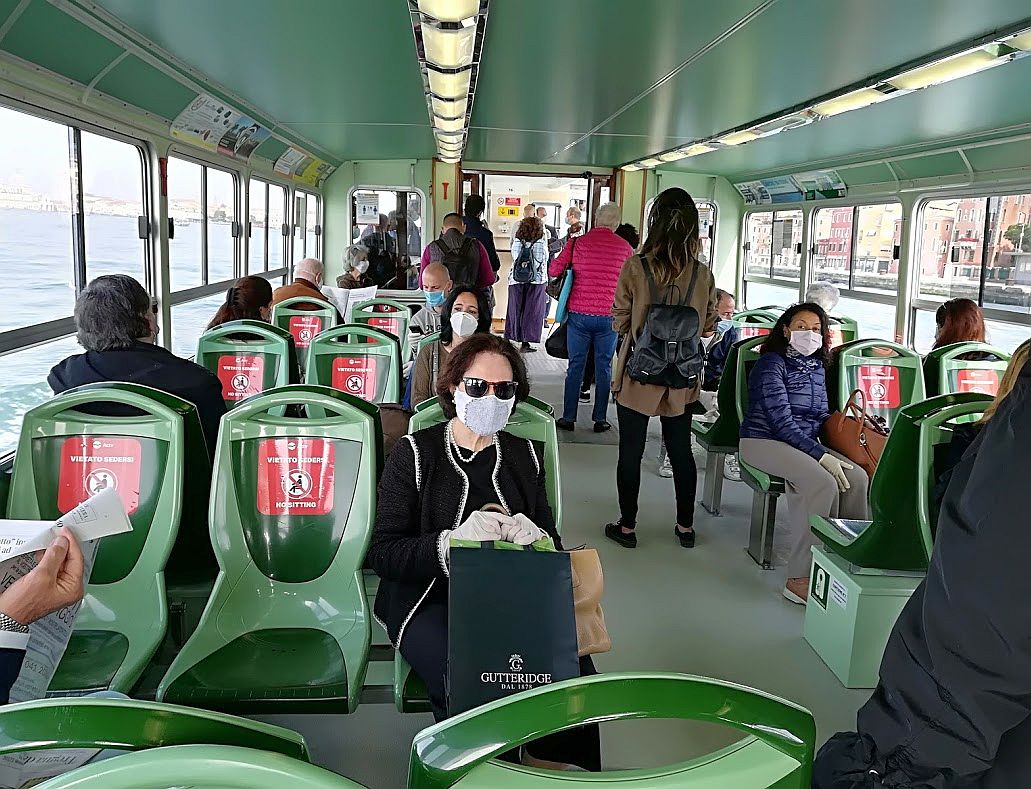
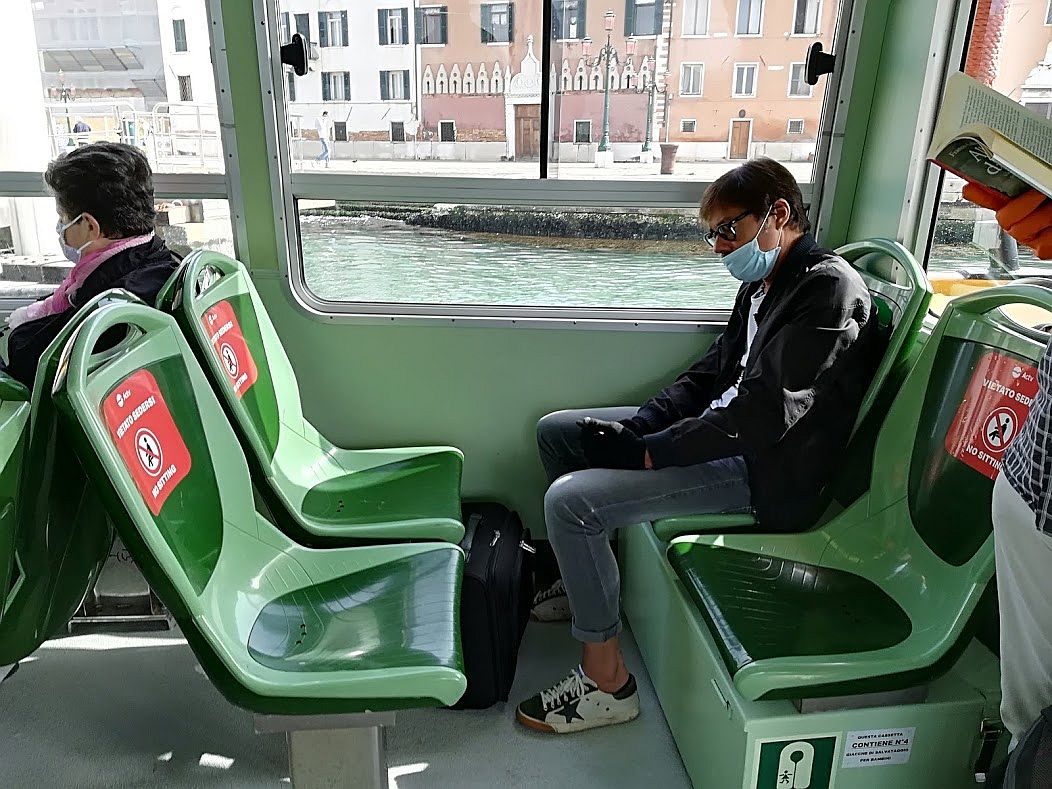

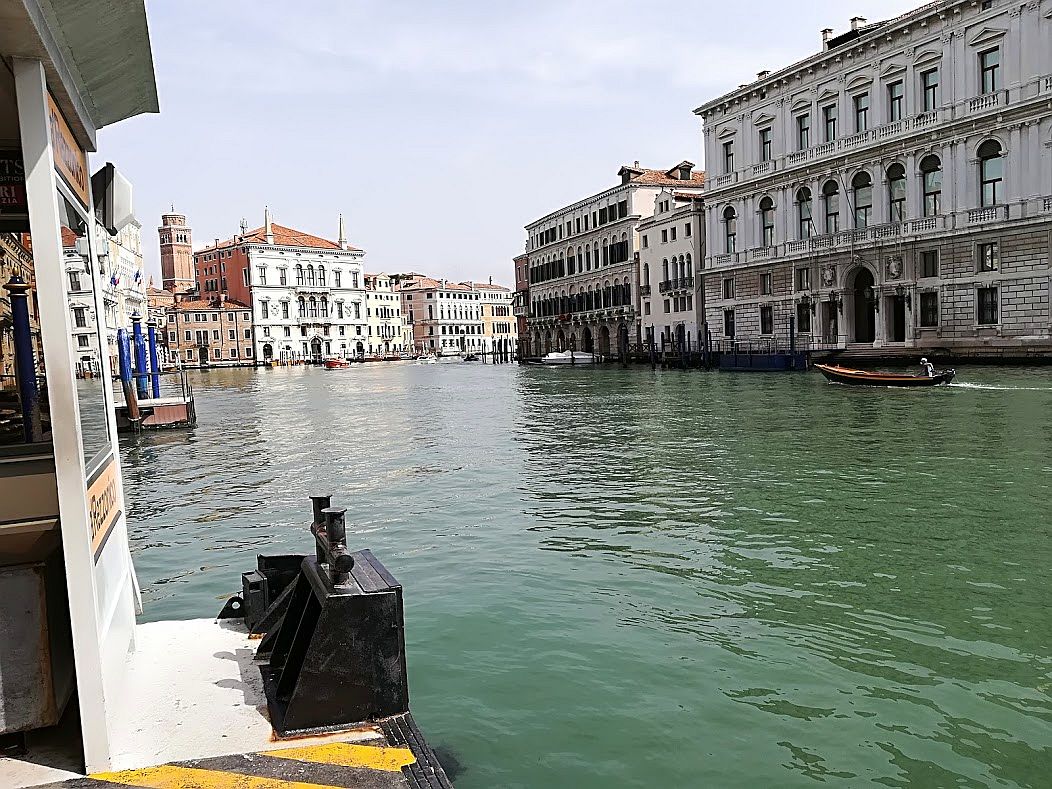
Let’s say that we might be dreaming to have tourists come back. Maybe not ALL of them, but a good number. Will distancing be abandoned and the vaporettos return to their former fall-of-Saigon ways? At the moment, the #1 is scheduled every 20 minutes, so that’s obviously unsustainable if you have any more than the current amount of locals riding. For one thing, the lines that would form in order to board would be unspeakably long.
And the lines would function only if everybody continued to obey the rules. A few days ago a small riot was on the verge of breaking out at S. Maria Elisabetta (Lido) when the vaporetto captain halted the boarding process because the maximum number of passengers had been reached. Everyone left on the dock released all that pent-up lockdown tension, and the Carabinieri were called to restore order. And — I repeat — those were only locals. Shall we add a few hundred tourists to the mix?
Fun fact: There are eight vaporettos on which a place can be booked, to ensure that you (or more to the point, the commuters) don’t get left ashore because the vaporetto is full. (There is also an app for booking, but I repeat, only on certain vaporettos.)
Not-so-fun fact: If you have an urgent need to take a vaporetto and it’s at its maximum capacity — as happened to a child in pain heading to the hospital with his mother for an urgent treatment — you still might not be able to board. Even doctors going to work have been left on the dock, waiting for the next boat. The ACTV explains that the staff isn’t permitted to decide who gets to ride and who doesn’t (this makes sense, because otherwise there would literally be no end to it). They say that if a passenger decides to disembark to give his place to someone else, the other people waiting on the dock have to give their approval.
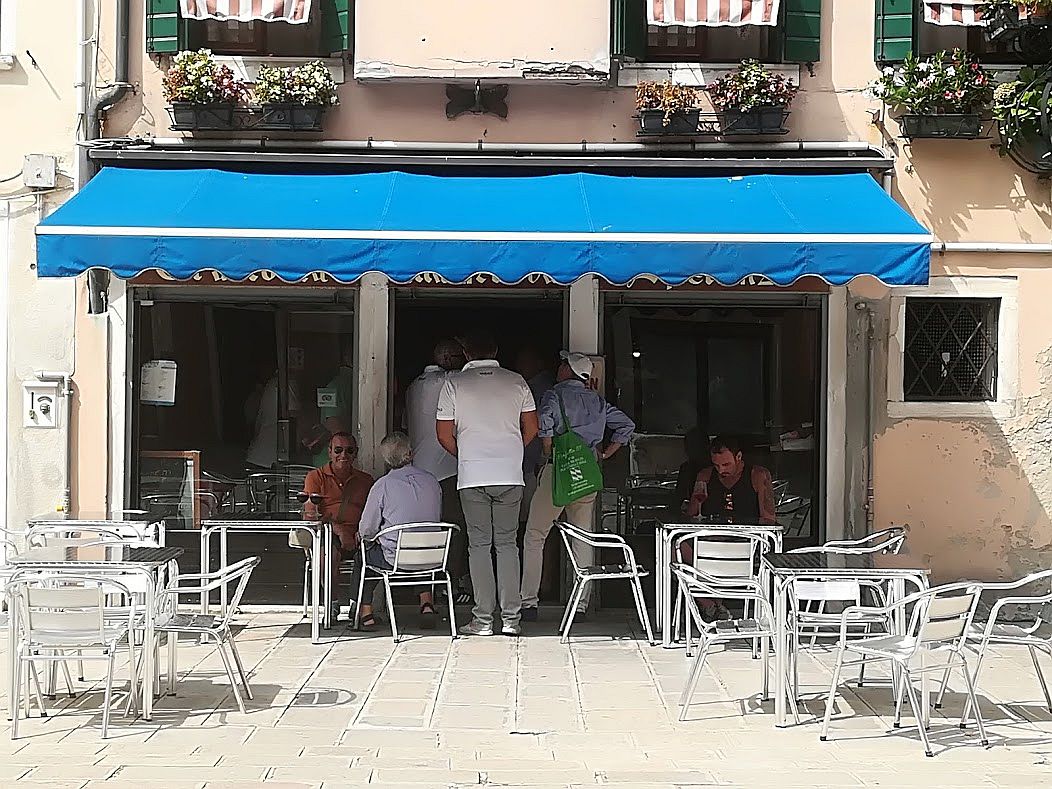
Bars/cafes: As is clear to everybody, customers have taken matters into their own hands in terms of buying and consuming (outdoors) the usual products of these indispensable establishments. A bar’s indispensability may have many definitions; to one person, it may mean the double espresso cappuccino they can’t make at home but without which life is not worth living, while to another person (me) it means the fabulously dependable places all over the city where you can count on finding a bathroom.
Feel free to snicker, but it’s going to die on your lips when you realize, as I did on the first morning of lockdown, that there was no Plan B for dealing with my first morning coffee’s progress once I was more than ten minutes away from home. We were going to our favorite butcher, a trip that requires 20 brisk walking minutes. And back. Plus the wait-time (unknown) to enter the shop, and the time in the shop. As we set out, I suddenly realized that if I had to go to the bathroom at any point, my only option was some nearby canal. I have nothing against using canals, but they don’t come with many secluded corners.
Not to dwell on this, but the total absence of cafe’s suddenly took on cosmic significance. How to sketch out an itinerary that takes into account that I will have to hold it till I get home? We all know that having to think about it makes it all much worse.
I will conclude this little meditation by saying that yes, we did walk to the Rialto market last Saturday for the first time in two months, and yes, after an hour and a half of travel (we were stopping for me to make photographs) I realized that the return trip was going to be a problem. Our favorite bar/cafe was open for takeaway! Our favorite barista/owner told me that nobody was permitted to enter! The wild look in my eyes inspired compassion and I snuck inside like some criminal who already hears the heavy tread of the penitentiary police.
I have the deepest respect for the owners of bars and cafes, but never realized till now that their supreme value isn’t in the beverages and snacks, but that they provide a link in the chain of civilized life without which all life has to stay within ten minutes of home.
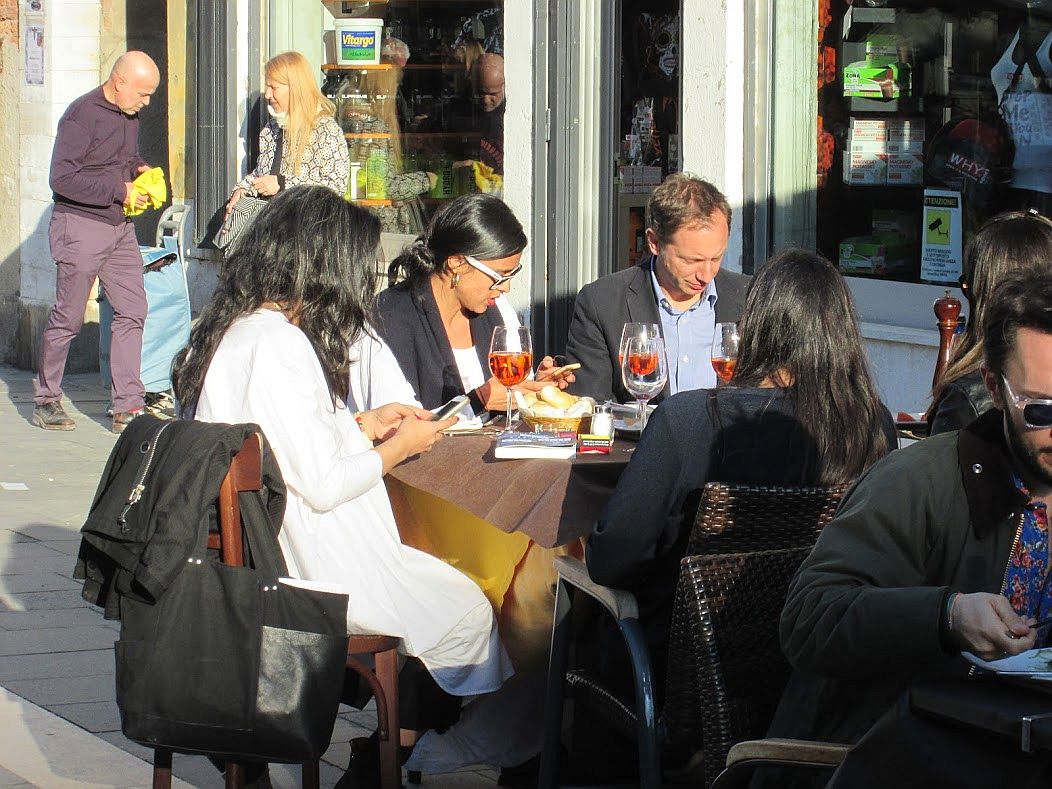
Restaurants: It’s not clear to me if the current system of takeaway will continue, but there is a s*#t-ton of rules for normal restaurant operation. Tables must be spaced four meters (12 feet) apart, and diners at the same table must be seated one meter (three feet) apart. Patrons must make a reservation (I’m not clear on how stringent that will be as time goes on), and the restaurant owner must retain the list of reservations for 14 days for possible tracing of customers. Diners must wear masks except (perhaps obviously) when eating; waiters will be wearing masks and gloves. No more printed menus. No buffets. Only credit cards will be accepted, to avoid contagion via cash. The locale will be disinfected daily, more than once.
There will be fewer customers because so far there are only locals around, but even if the customers are tourists there will be fewer tables due to the shrinking of available space to seat them.
Arrigo Cipriani has stated that he isn’t going to reopen Harry’s Bar for the foreseeable future. If he were to space out the tables in the famous bar according to the law, not only would he be left with something like a mere four tables in that small space, but the atmosphere would be deathly, and I don’t mean because of the virus. Also, it’s preposterous to think of making any money with so few tables, even though the upstairs restaurant is somewhat more spacious. The geometry is ruthless.
To sum up: There are some 336,137 restaurants in Italy employing 1,200,000 workers. It has been estimated that under anti-contagion regulations, 80 per cent of restaurants will not be able to reopen.
Hair salons/barbers/beauty treatments: This is really going to be fun (oh, I sincerely think not. Not for anybody). There is an infinity of new decrees for the providers and purveyors of beauty. Here is a clip that circulated on WhatsApp showing somebody’s fantasy of how your average salon will have to operate under the new distancing/disinfection rules:
So much for joking. From now on, hair salons will accept customers only by appointment. They will be allowed to open on Monday and even on Sunday. No more magazines or newspapers lying around to be leafed through by thousands of contagious fingers. Single-use capes. The towels may be reused, but before washing they must be kept in a closed, impermeable bag, then washed for 30 minutes at 140 degrees F (60 degrees C).
Shops Owners must guarantee cleanliness, disinfecting the store at least twice a day. There must be gloves, as well as disinfectant gel, available at the entrance.
Beaches, swimming pools, etc. will be opening with another batch of spacing rules (umbrellas, group sports on the beach, space between swimmers). There has been some excited comment about not requiring lifeguards to wear masks. Important? Not? I can’t decide anymore.
Mass Finally the priests will be celebrating mass. The number of persons allowed in church will be limited (think tags of tape on the pews to indicate spacing). Masks and gloves required. Communion wafers distributed and accepted only with single-use-gloved hands. It says in the newspaper that entrance will be forbidden to anyone with a temperature above 37.5 degrees C (99.5 degrees F). It doesn’t say who is going to be checking these temperatures.
In conclusion: We’ve been told a million times by now that this new phase is experimental; if any of the virus numbers begin to increase, back we all go to square one. “The virus hasn’t disappeared,” virologist Dr. Andrea Crisanti told La Nuova Venezia. “And with the reopening, we hope for the best, but we need to prepare ourselves for the worst.”
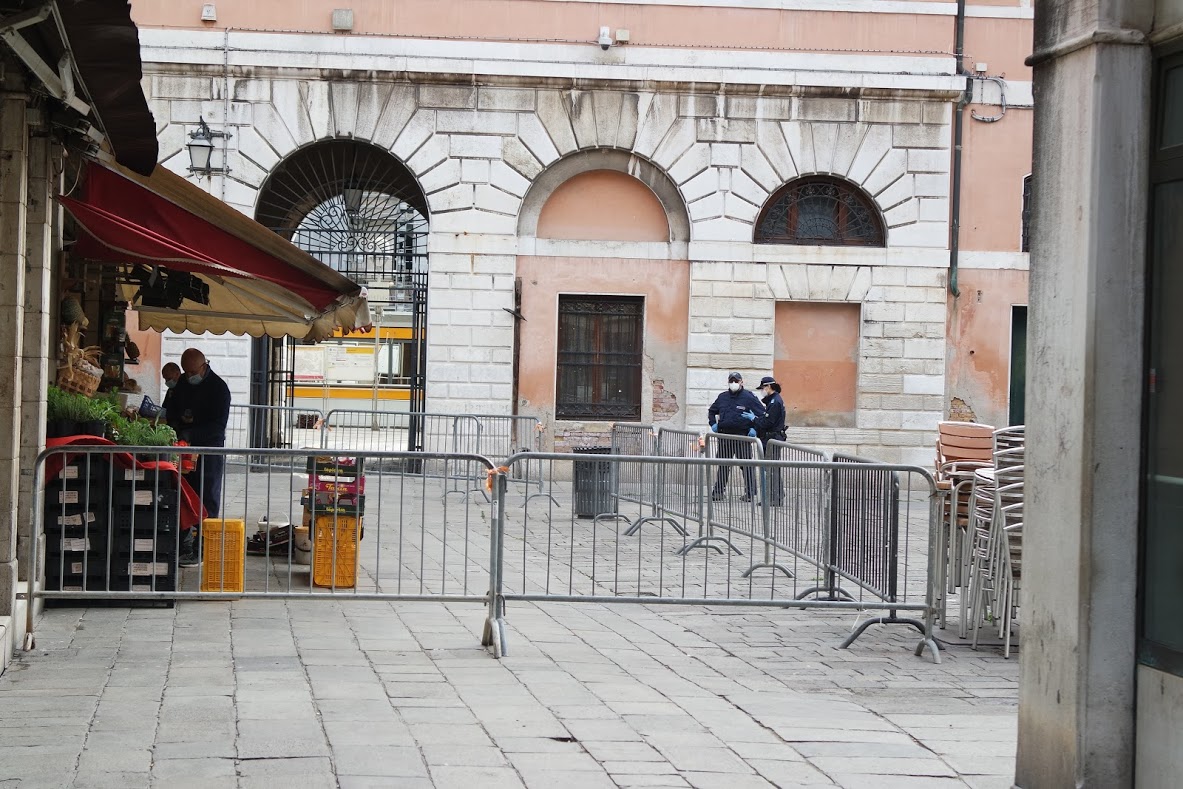
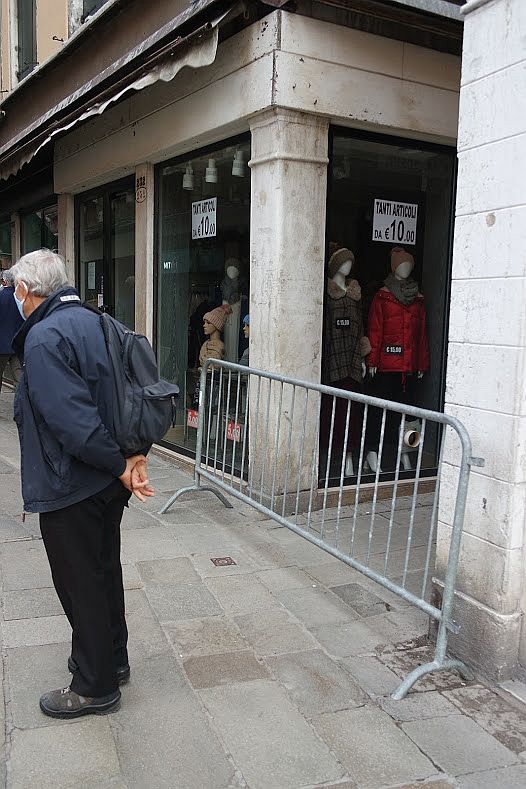
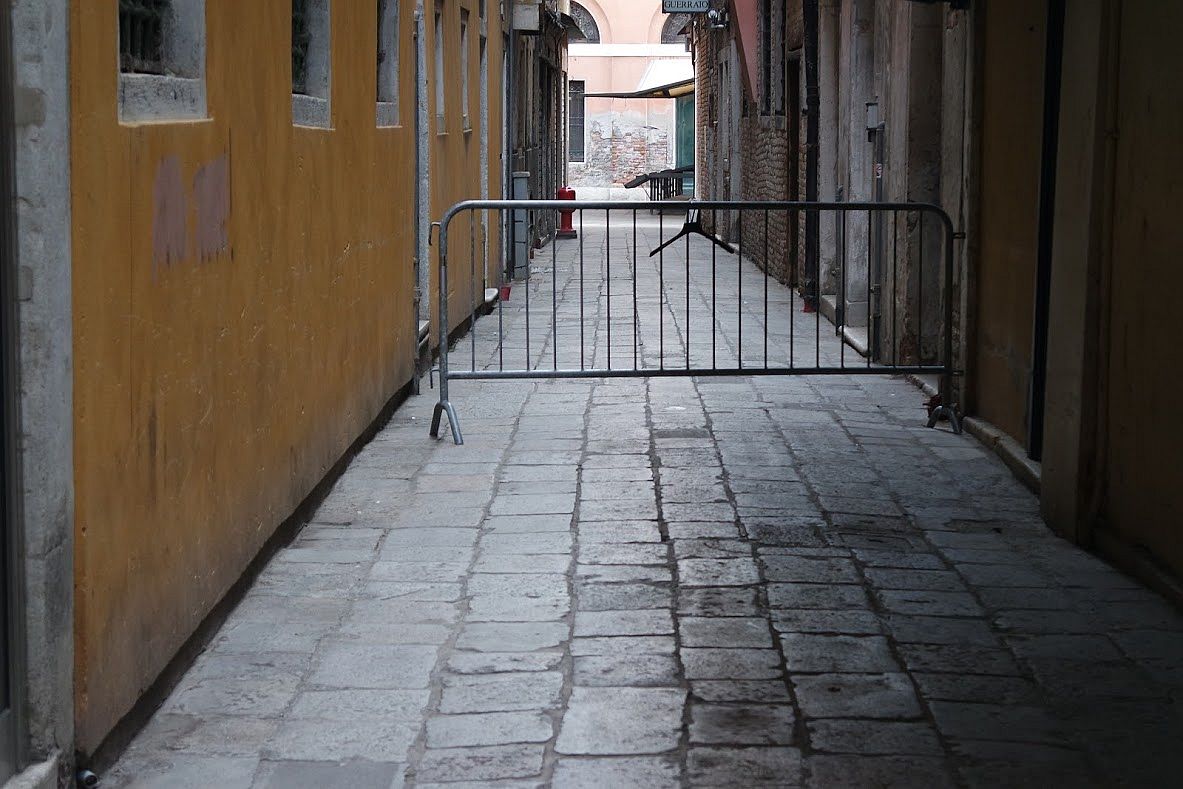

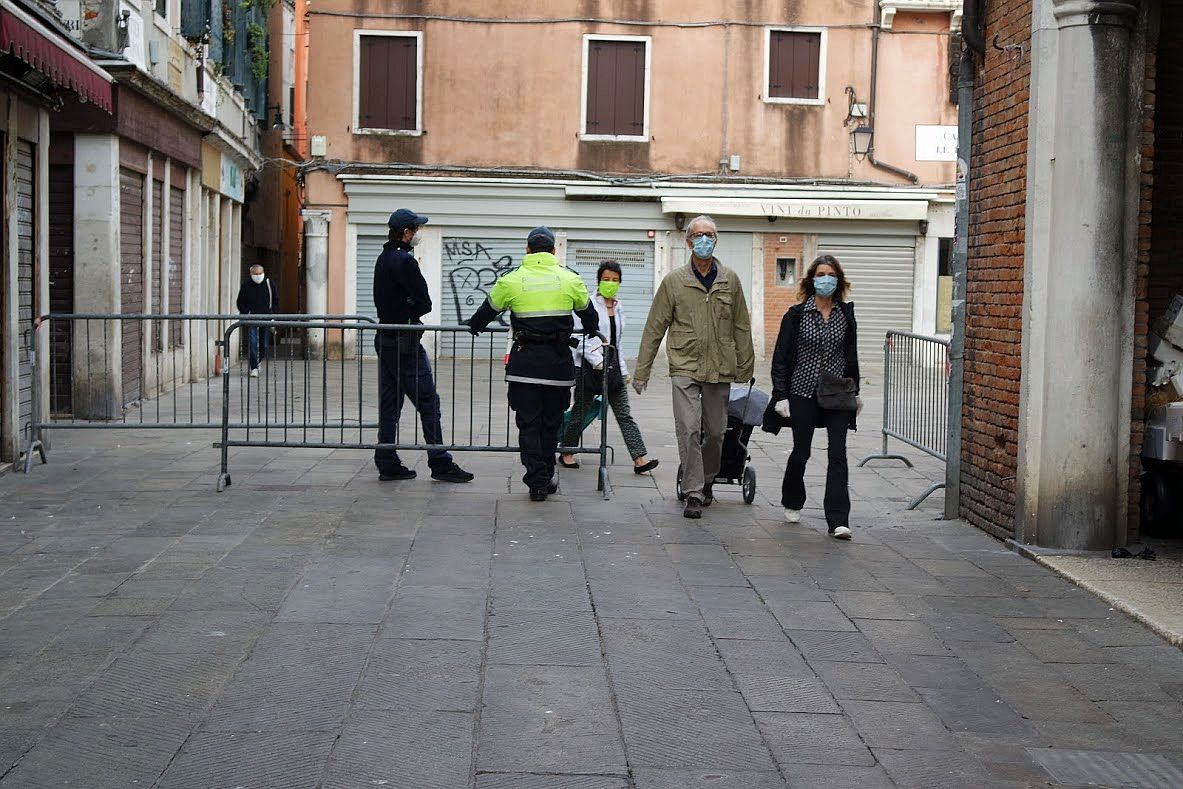
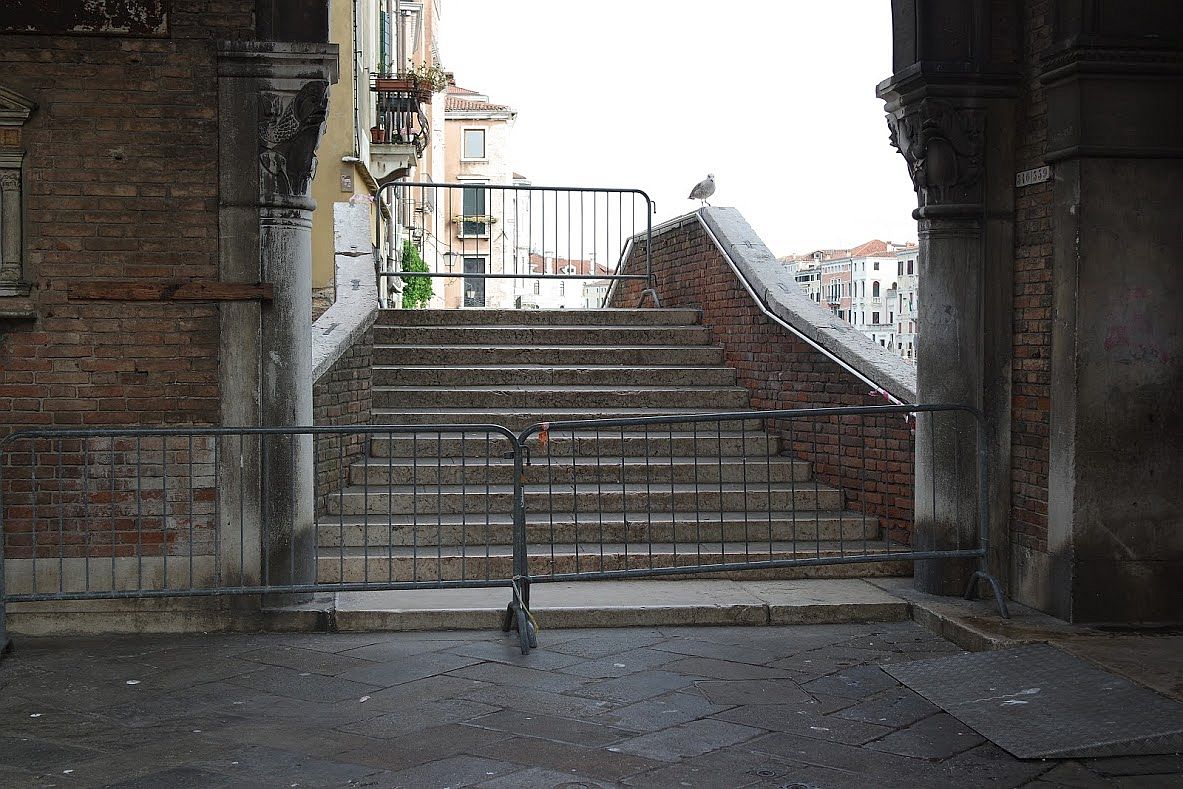


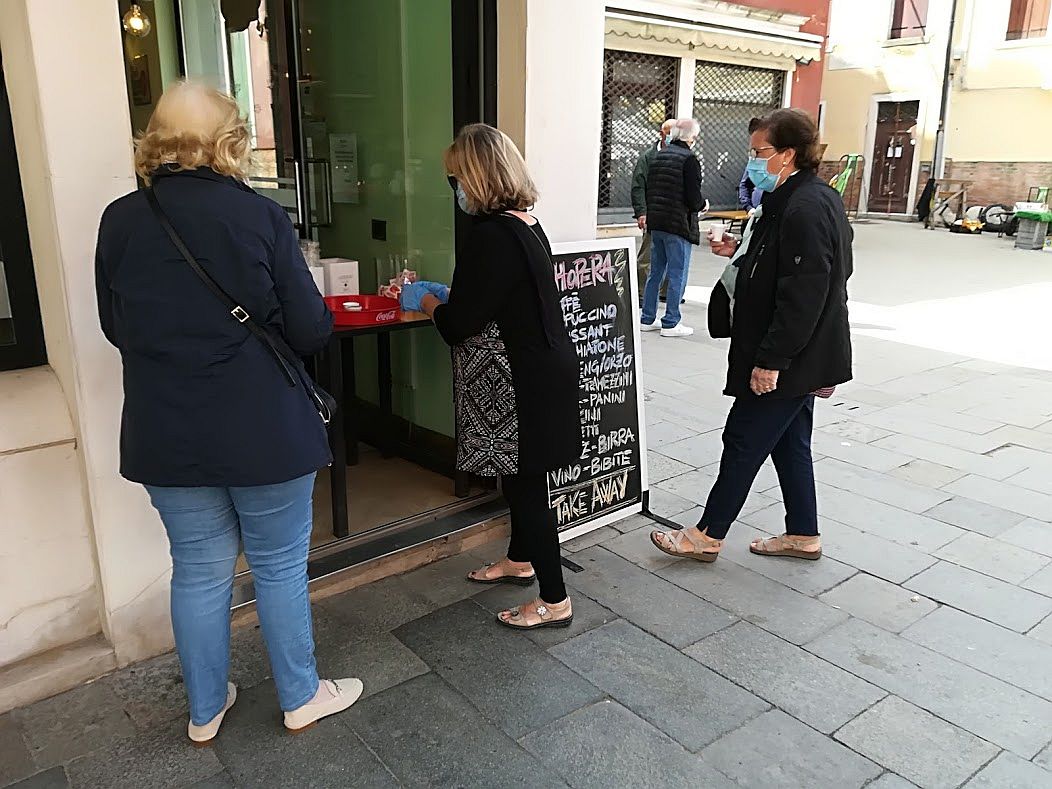
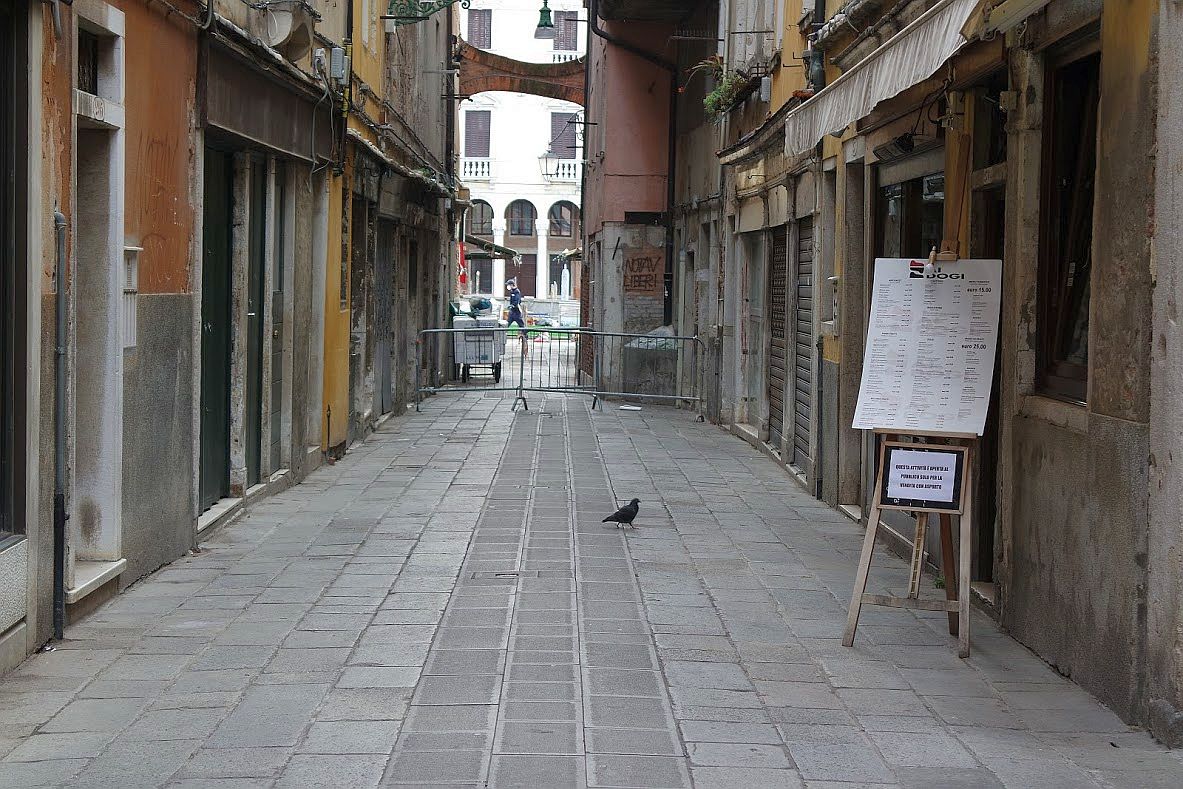
6 Comments
Wow…this. “ To sum up: There are some 336,137 restaurants in Italy employing 1,200,000 workers. It has been estimated that under anti-contagion regulations, 80 per cent of restaurants will not be able to reopen.”
I have stubbornly held onto our Air BnB reservations for August/September, just…in…case… we have been refunded our airfare, but can purchase again if the way clears.
Hope you and Lino are keeping well and entertained.
Polly
Hi Erla,
Hopefully careful re-opening can be, as Churchill put it, “the end of the beginning”. To deprive people of their livelihoods and their daily routine will, of course, also take a toll on people so even if it, theoretically, would be best people can’t stay penned up too long a time. I’m glad to see that Venice, and Italy, is starting to carefully find a new normal in this.
We have done our best to keep away from unnecessary contact with people but this have brought on some good things also. I don’t think I’ve spent so much time with my parents since moving to Stockholm in 2006. We call on FaceTime and also have dinner together the same way. We can’t meet physically but it seems more important to keep contact in other ways. It feels nice, though, that my parents seem healtier than ever. Long walks in the forest seem to have become their pass-time and they had even gone on picnics which they, according to mother, hadn’t done since the days of Gustav VI (which made a silly rhyme in Swedish).
I’m glad to hear that things are going reasonably well for you, and yes, as long as we don’t fall ill, the whole business of reconnecting with people has been a huge plus for lots of people, including you. So there is that….
Thanks Erla for this comprehensive review. I saw a documentary on PBS filmed in a hospital in Cremona about the corona virus. It covered March through May. Very well done. NYC is still on lock down but some areas in NYS are beginning to slowly open up.Hopefully there will not be a resurgence of the virus.
Keep your stories coming.
Thank you, Dian
It must have been a huge relief when this started happening.
Of course it was — as it was a relief everywhere when life began ever so tentatively to return to normal. I’m sure the same feeling crept through Bognor Regis.